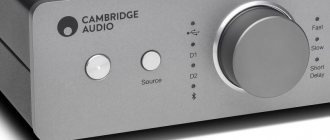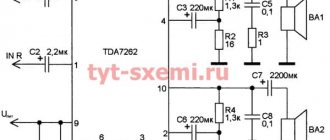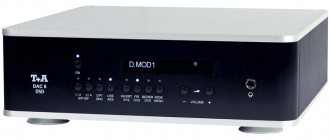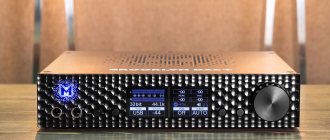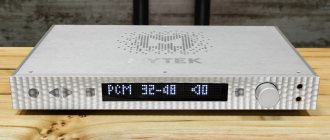External DACs have been produced for decades, and during this time an amazing “zoo” has developed, in which the newest models do not always sound more interesting than their predecessors, and exotic technologies are experiencing more and more new incarnations. Our hero today is interesting because he appeared on the market several years ago, but, apparently, he has no intention of retiring.
It must be said that the Cambridge Audio developers are generally not inclined to update their lineup at machine-gun speed. And this is right - serious technology does not tolerate fuss and haste. At the moment, the catalog of the British company, which, by the way, recently celebrated its 50th anniversary, presents two DACs - and DacMagic Plus is the most advanced and multifunctional in this tandem.
The external design of many Cambridges is unobtrusive, but so characteristic that the devices are instantly recognized without even looking at the logo. Well, our small box also sports a round branded overlay on the top of the case. True, this disk is so similar to an adjustment wheel that at first you are tempted to turn it with your finger.
The front panel of DacMagic Plus is rich in indicator LEDs, however, thanks to their literally pinpoint sizes, they do not disturb the feeling of noble minimalism.
If you look at the device from the rear, then due to the large number of small inscriptions and different-sized connectors, including XLR, the box is associated not so much with home Hi-Fi, but with some kind of professional module.
It makes sense to dwell on switching in more detail, since this is where one of the main features of DacMagic Plus lies. In addition to the USB-B port, which is obligatory in these days, there are two pairs (optics + coaxial) of S/PDIF inputs, as well as similar connectors for outputting signals to external digital devices.
Balanced outputs and especially the Ground Lift switch hint at the possibility of working in professional setups
There are also two analog outputs: tulips and balanced XLR. In fact, there is also a second USB port, but it is intended mainly for connecting an external Bluetooth dongle. In the Cambridge Audio catalog, the “whistle” is called VT100 and here in Russia you can buy it for about 4,500 rubles. Not cheap, of course, but it understands the aptX protocol, remembers up to eight connected devices and supports a proprietary upsampling system. However, we will talk about it a little later.
Not just a DAC
By and large, DacMagic Plus is not just a DAC, but a whole combine, including a preamplifier with switchable digital inputs and a headphone amplifier. Interestingly, its volume control cascade can be switched off. During initialization, it is enough to press the volume level drum - and a linear signal will be sent to the outputs.
By the way, this control is completely digital, and in order to get from minimum to maximum volume, you will have to turn it three turns. And all this time you will feel lightweight plastic under your fingers. Unlike the rest of the design elements, it is made in a rustic way, however, without touching the device, it is almost impossible to notice this.
But let’s return to the functionality, which is simply surprisingly rich in today’s times. For example, a separate button is responsible for selecting the type of analog filtering of the DAC. Three values are available: linear and minimum phase, as well as a filter with an increased cutoff slope. And if you hold this button longer, inversion of the global phase of the signal will turn on.
The DacMagic Plus uses a pair of well-known 24-bit dual-channel Wolfson WM8740 chips as digital-to-analog converters. Their own characteristics: a signal-to-noise ratio of 120 dB with a total distortion of 104 dB (in single-channel mode), support for PCM signals with sampling rates up to 192 kHz and, for better or worse, no compatibility with the DSD format.
The hardware itself is indeed capable of working with asynchronous streams up to 24 bit/192 kHz, but you need to keep two tricks in mind. Firstly, by default its USB interface operates in version 1.1 mode - accordingly, it refuses to accept high-resolution tracks (more than 48 kHz). Switching it is not difficult, you just need to remember to do it. Well, secondly, when playing rare recordings at 32 kHz, the sampling rate indicator remains turned off. But don’t let this scare you - everything works, it’s just that there is no LED for this mode.
Top 5 – stationary USB DACs
Preparing the computer
For an audio system, the ideal computer is one that makes no noise at all. If we talk about ready-made solutions, then you can’t find a better laptop or ultrabook, especially if it has a solid-state drive (SSD) installed instead of a traditional hard drive. Nettops (compact system units with “laptop” electronics) or so-called platforms are also held in high esteem - almost ready-made miniature system building blocks that need to be retrofitted at will. A good example is the NUC series from Intel. With a full-size system unit there is more trouble, since it will not be possible to make the colossus truly silent in half an hour. An integrated approach to solving this issue is required. First, you will need a “quiet” case. It should be a massive structure with a minimum number of holes and seats for fans with a diameter of at least 12 centimeters. It is advisable to cover the inside of the body with special materials to improve the noise and vibration insulation properties of the box. It is most convenient to use self-adhesive sheets of bitumen rubber and foam polymer for tuning cars. Of course, these modifications should not interfere with the normal operation of the electronics or reduce the fire safety of the structure. Secondly, you need to use the quietest components possible - the already mentioned SSDs, a video card with passive cooling, large and low-speed fans for the processor and case ventilation. If this is not enough, you will need to further slow down the fans to the lowest possible speed. This is done using a fan control unit or simple resistors connected to an open circuit. It is quite obvious that getting involved in the process of building a quiet system unit only makes sense if you desperately need high performance to solve a variety of problems. If you choose a purely musical computer, then it’s better not to mess with full-size machines. The prices indicated in the article are indicative.
Current at the end of December 2015 Price – 49,000 rubles.
The manufacturer calls the irDAC model a new milestone in the development of this family of equipment. Among other things, it is mentioned that there is a remote control from which you can control the volume, select input and control playback in cases where there is a wired pairing with a compatible device. True, the remote control looks like it was bought in the nearest tent near the metro for a couple of hundred rubles. Formally, Arcam irDAC is “tailored” for Apple products, but in fact there are no restrictions for working with any other gadgets and computers, since the USB input is standard here and 24/192 support is available. The device is based on TI PCM1796. These are really cool chips that can deliver phenomenal sound quality. But the king is largely made by the retinue, that is, the “piping” of the DAC chips, and the Arcam irDAC has nothing to brag about in this regard: inside the aluminum case there is a printed circuit board with a good, but by no means sensational, set of related electronics and quite “earthly” capacitors. External power supply. To be honest, when looking at the design, one is perplexed as to why this device is valued at almost 50,000 rubles. However, during listening, the nature of emotions changes: the device sounds clean, rhythmic and detailed. However, the Arcam irDAC is still overpriced, especially considering the lack of a headphone output and a balanced output. If you are not inclined to react painfully to this kind of nuances, take it boldly, because the Arcam irDAC sounds really lively and rich. Well, although we included it in the top five worthy ones, we didn’t let it go beyond fifth place: for that price there are better options.
Pros:
compactness, decent converters, energetic sound, remote control included.
Minuses:
modest appearance, too ascetic-looking remote control, no DSD support, no balanced output and no headphone output.
Mandatory upsampling
Well, now the most important point. Regardless of the source parameters, any signal in DacMagic Plus is upsampled to 24 bits/384 kHz. The Analog Devices ADSP-21261 signal processor is responsible for this operation. This chip, which belongs to the third generation of the high-performance SHARC line, is programmed in accordance with ATF2 algorithms developed by the Swiss company Anagram Technologies.
Such a digital switching kit is almost impossible to find these days.
ATF stands for “Adaptive Time Filtering,” and the essence of this technology is interpolation of the signal envelope using polynomials. According to the creators, it works much more correctly than other upsampling methods. In addition, the process provides deep buffering of the digital stream to suppress jitter. Apparently, Cambridge Audio really takes the capabilities of ATF2 very seriously, because in DacMagic Plus it is not possible to disable it in principle.
So, we have before us a fairly advanced DAC, to which, in addition to a computer via USB and mobile gadgets via Bluetooth, you can connect two more digital sources via S/PDIF. Thus, for example, you can integrate an SACD player, satellite receiver or game console into the setup. The subtlety is that DacMagic Plus is a purely stereo device, and it does not decode multi-channel Dolby Digital or DTS streams. However, their switching does not cause problems, so no one bothers to receive 5.1 bitstream from the digital output and send it further to the home theater receiver.
By the way, an interesting point is that no signals are upsampled before being sent to the S/PDIF output, due to which the device can be used as a transmission media converter. For example, to connect some exotic DAC to a computer that cannot work independently via USB.
Cambridge Audio Azur DacMagic Plus DAC amplifier
Released more than five years ago, Cambridge Audio's DacMagic digital-to-analog converter has recently been replaced by a more modern version with the Plus prefix. It has an improved USB interface, added support for the Bluetooth module and a built-in telephone amplifier with higher performance. This modernization served as the reason for another acquaintance.
The new device, like its predecessor, is based on a pair of 24-bit Wolfson WM8740 converters, which, despite their considerable age, have very high performance. Otherwise, the “plus” DAC is significantly superior in functionality to the regular DacMagic. The USB interface has been upgraded to 2.0 specifications and now supports asynchronous audio streams up to 24-bit/192 kHz. The BT100 Bluetooth module, compatible with the AptX codec, can be connected to an additional USB socket. The Analog Devices ADSP21261 processor, which upsamples input data up to 24 bits/384 kHz, is responsible for digital filtering (using patented Anagram Technologies algorithms) with three switchable modes. And the ability to adjust the level on the analog outputs - regular and balanced - turns this small box into a full-featured digital preamplifier serving up to four sources.
Since the analogue path remained unchanged - after the DAC, the signal passes through a double differential filtering/amplification circuit with a paired virtual ground - I did not test the device with an external amplifier. You can read about how DacMagic sounds from the line output here. Of greatest interest to me was the built-in telephone amplifier, compatible with both low- and high-impedance headphones. So DacMagic Plus is a good all-in-one solution in terms of price/quality for listening to music from a laptop, tablet or smartphone, which, as a rule, high-end home stereo phones cannot handle properly.
The increase in dynamics, speed, and clarity is clearly noticeable. Tonal neutrality has increased. There are no obvious distortions in the tonal balance.
The high-resistance open Sennheiser HD-600 became the first test for DacMagic Plus. Configuration: laptop, USB, software playback of music rips in WAV 16/44.1 format. The result is much better than when listening directly from the computer's telephone output. The increase in dynamics, speed, and clarity is clearly noticeable. Tonal neutrality has increased. There are no obvious distortions in the tonal balance, although the lowest register, as it seemed to me, is still a little underdeveloped. The only thing that was alarming was the rendering of volume – the voices and individual instruments sometimes lacked materiality and delineation in the space of the stage. By switching filtering modes, I tried to add physicality to the sound, but none of the settings gave the desired result, although the experience turned out to be interesting: in one case, the detail at the top was slightly increased, in another, the converter produced a slightly more massive bass.
But when I moved on to listen to the FLAC 96/192 HD files, the desired physicality came through better. The sound atmosphere was more fully formed, and all the instruments in the higher register were reproduced even more recognisably and accurately.
Switching to stereo phones with standard 50 Ohm impedance (low-sensitive closed Denon AH-MM400 and highly sensitive armature CLEF TH-ECBA700) left ambivalent impressions. The sound of large headphones turned out to be much softer and freer than usual, and on the earbuds, on the contrary, all channel high-frequency resonances emerged even more clearly. But in each case, the microdynamics improved noticeably and there was not even a hint of overloading the amplification path.
Final experiment: closed isodynamic OPPO PM-3 with a resistance of only 26 Ohms, which is lower than recommended for DacMagic Plus. Despite this, the result is beyond criticism. The bass cleared up, the top sparkled with numerous details, and the entire range acquired full dynamics, while maintaining neutrality. And in the middle, which I especially want to emphasize, there was no noticeable hardware gag.
Cambridge Audio Azur DacMagic Plus
Manufacturer: Cambridge Audio (UK)
www.cambridgeaudio.com
Inputs: 2 x Coax, 2 x TosLink, USB Type A/B, Bluetooth || Outputs: Coax, TosLink, RCA, XLR, Phones 6.3mm || RCA/XLR line output voltage: 2.1/4.2 V || Output Impedance: 50 Ohm || Reproducible range: 20 - 20,000 Hz with unevenness +/-0.1 dB || Distortion: 0.001% || Signal to noise ratio: 112 dB || Dimensions: 52 x 215 x 191mm || Weight: 1.2 kg || Price: 37990 rub.
COMPONENTS
- Laptop Apple MacBook Air A1465
- USB cable Furutech GT-2 5 m
- Power Distributor Supra LoRad MD-06-EU Mk II
share
Tags: Cambridge
Light and open
I don’t know how it is for anyone, but for me, listening to equipment with upsampling turned on often causes subconscious anxiety. Excellent resolution at high frequencies may seem slightly exaggerated, and moderate dynamics can also be considered a sign of unnatural compression. So, in our case, the interpolation of the original signal actually occurs extremely correctly and does not give any reason for paranoia.
Another thing is that DacMagic Plus itself sounds quite light and open, especially on high-resolution content. There is no talk of excessive brightness, but the crystalline nature of its sound signature must be kept in mind when planning a setup.
A Great Way to Save on a Headphone Stand
As for the music resolution itself, for this price range I would call it quite decent. This logically results in a good elaboration of the music scene with good depth and correct positioning of sources. True, instruments with a low-frequency spectrum sometimes seemed somewhat reduced in scale and significance in the overall picture. And therefore, bass speakers or moderately darkish “ears” would obviously be in place here - they will add solidity to the low end, while they already lack controllability and structure.
By the way, about headphones. The nature of their path is, in general, similar to that of a preamplifier in conjunction with active monitors, but sensitivity and impedance play an even more significant role here than usual. With low-impedance “ears” the sound is detailed and airy, and warmth and solidity appear in it exactly in the proportions that were intended by their creators.
The DAC comes with a compact stand for vertical installation and a switching power supply
For testing I mainly used the new Quad ERA-1 open planars. With a sensitivity of 94 dB/mW, their impedance is only 20 ohms. Formally, they do not even fall into the recommended range for DacMagic Plus (32–600 Ohms), but this did not stop “Era” from playing the test material perfectly, adequately revealing the bass dynamics and not allowing ultra-fine details on the high frequencies to mix in the interference mess.
And in general, in terms of the ratio of sound class and price, this new product was a pleasant surprise. But with high-impedance headphones, the experience turned out to be less optimistic. The drive in the sound has decreased somewhat, so it is better not to approach the upper limit of the impedance. On the other hand, along with softness, the sound acquired a slight but very comfortable warmth. So there is a lot of room for experimentation here.
